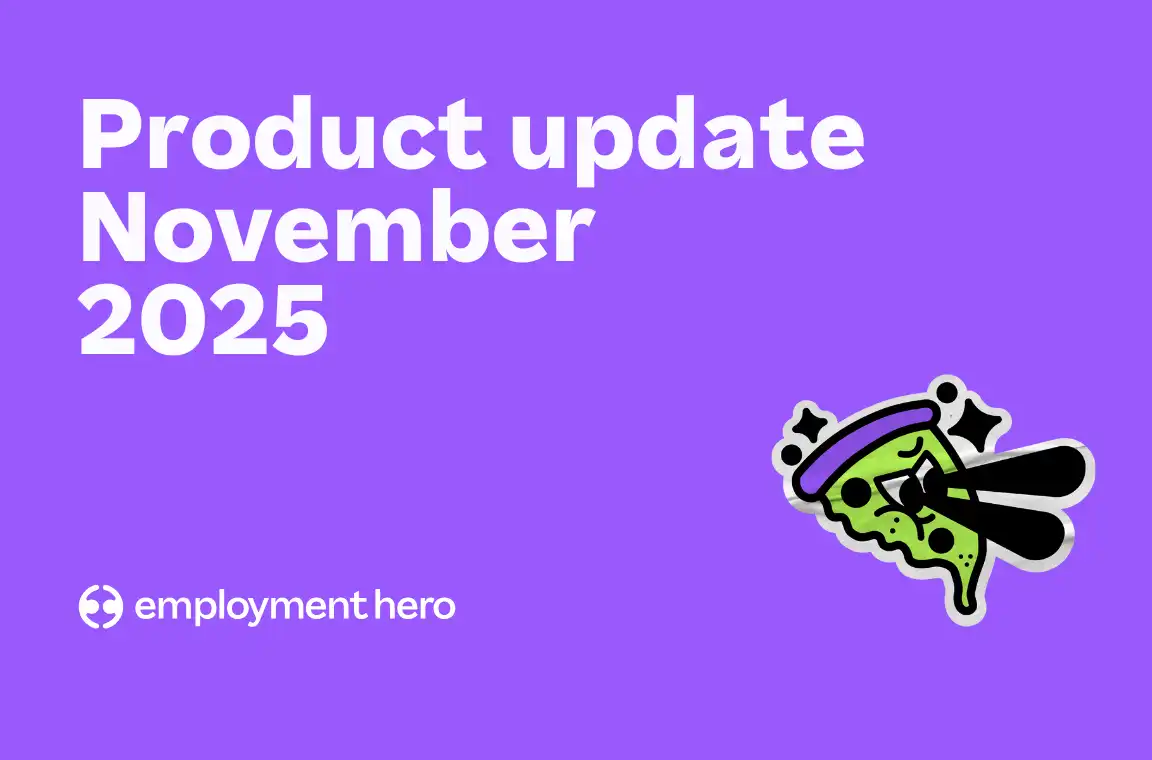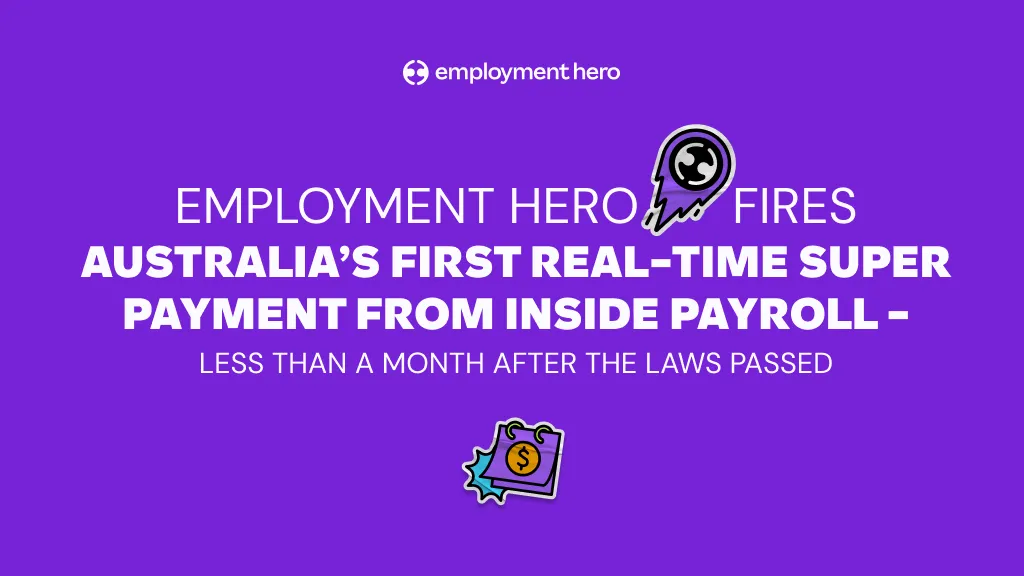Guide to managing contractors in Employment Hero
Published
Guide to managing contractors in Employment Hero
Building successful partnerships with contractors can make a huge difference to your business. It’s additional support when you need it most. However, managing contractors can be a HR challenge, especially when you need them to hit the ground running.
Employment Hero can help. Whether you’re hiring contractors for the first time or are a seasoned pro, this guide takes you through Employment Hero’s tailored features for managing contractors.
What’s included in this guide?
This comprehensive resource walks you through every stage of working with contractors, from initial hiring to ongoing management. You’ll discover practical strategies to help your HR team build stronger relationships with independent contractors whilst achieving your project goals.
In this guide, we’ll cover:
- Recruitment: Find the right talent instantly with Employment Hero’s SmartMatch and organise the whole process with the Applicant Tracking System.
- Onboarding: Get your contractor set up with the company before they’ve even started their work, with our easy online onboarding and agreement templates.
- Personnel data: Set up a digital file for your contractor so you’ve got one single source of truth for all their details.
- Project management: Give them the information they need with centralised briefing documents that can be easily assigned to different employees.
- Timesheets and payroll: Paying your contractor correctly and on time with our comprehensive timesheet and payroll management features.
To download the guide, complete the form on the right.
What defines a contractor?
Before you begin hiring contractors, it’s essential to understand the distinctions between different employment types. These classifications affect everything from tax obligations and legal responsibilities to how you’ll manage these team members.
Getting this right from the start helps protect your organisation from compliance issues whilst ensuring you create the right working relationship for your project needs.
Is a contractor an employee?
No, contractors are not employees. Instead they are contracted independently to provide work or services.
The key difference lies in the nature of the relationship: an employee works for a business, while a contractor runs their own business and usually provides services to various clients. Unlike employees, contractors have a high degree of control over their work, are not entitled to benefits like paid leave, and are usually responsible for their own taxes and business expenses.
It is important to note that in some circumstances, businesses can be required to make superannuation contributions for contractors and/or to deduct payroll tax (this information is on payroll tax in NSW, but similar obligations in other states and territories).
Managing contractors: Benefits and challenges
Working with contractors can transform how your organisation approaches projects and manages resources. Understanding both the advantages and potential hurdles of contractor relationships helps business leaders make informed decisions about when to hire a contractor versus hiring an employee.
Let’s explore what makes contractor talent valuable and how to overcome common obstacles.
Advantages of hiring contractors vs. employees
Bringing contractors into your team offers several strategic benefits that can help your organisation become more agile and cost-effective. Many HR leaders find these advantages particularly valuable when managing fluctuating workloads or accessing specialised skills for specific projects.
One of the biggest advantages is cost efficiency. Since contractors are not permanent employees, businesses don’t need to pay for employment benefits. Additionally, you can save on overhead costs like providing office space, equipment and other resources.
Beyond financial savings, working with contractors provides access to specialised expertise. Independent contractors often have niche skills honed from working with a variety of clients and industries, bringing a wealth of knowledge that can be a game-changer for your projects.
Finally, hiring additional talent without the commitment offers your business flexibility and scalability, allowing your team to adapt quickly to changing business needs without hiring an employee.
Common challenges when managing multiple contractors
Contractors can bring many benefits to a business, but they also introduce some challenges. One major hurdle is difficulty getting them integrated into your business and ways of working. Unlike permanent employees, contractors aren’t typically immersed in your company culture or established workflows. This can make it hard for them to fully grasp your organisation’s unique values, communication styles and internal processes, which may lead to misunderstandings or a need for more extensive onboarding.
Another key challenge is the potential for quality inconsistencies. Since you’re working with different individuals on a project-by-project basis, it can be difficult to maintain a uniform standard of work. Ensuring every contractor delivers the same level of quality requires you to implement robust review processes and clear, detailed guidelines for each project to keep things consistent.
Lastly, there are compliance risks to consider. If a contractor is incorrectly classified and is found in reality to be a permanent employee, your organisation could face significant legal and tax implications. It’s crucial to understand the legal distinctions between an independent contractor and an employee to protect your business from potential penalties.
The importance of contractor onboarding
A thoughtful onboarding process transforms external contractors into valued team members who understand your expectations and working methods. Unlike full-time employees who might have weeks to settle in, contractors are often expected to deliver results quickly.
A structured approach helps independent contractors integrate smoothly, access necessary resources and begin contributing effectively from day one. Here’s how you can create an onboarding process that sets both your organisation and your contractors up for success.
Streamlined admin
The administrative side of contractor onboarding can take a lot of time and effort. That’s why a centralised digital platform like Employment Hero can make a big difference. It’s a single place to track and store contracts, invoices and onboarding documents, so you can quickly share the right information with your new contractor.
Best of all, all that information can be shared with the contractor before their first day, so they can get started right away.
A clear project kickoff
The initial project kickoff sets the tone for your entire contractor relationship. A well-structured kickoff helps prevent misunderstandings and builds confidence on both sides. Make sure to introduce key stakeholders, provide plenty of context and check that the contractor has everything they need to begin their work.
Remember, unlike full-time employees, contractors don’t usually have the benefit of informal office conversations where they might pick up additional context. The key is to be intentional about sharing relevant background information and encouraging questions during the kickoff.
Using contractor management systems
As your organisation scales its use of contractor talent, the spreadsheets and email threads that once managed a handful of contractors quickly become insufficient. People management systems with features built for contractors can centralise employment, creating a single source of truth that reduces administrative burden whilst improving compliance and visibility.
Employment Hero includes a number of different features to support employers when managing contractors:
- Comprehensive talent management – An applicant tracking system that handles all elements of the recruitment and onboarding process
- Streamlined documentation – Contract generation, e-signatures and secure storage for agreements and forms
- Project tracking capabilities – Features to monitor milestones, deliverables and deadlines
- Timesheets and payroll features – Easy timesheet management and payroll that can easily be customised to match your business relationships.
Manage your contract workers with ease
Managing all these aspects of contractor relationships doesn’t need to be complicated. With Employment Hero’s all-in-one HR solution, you can manage both employees and contractors in one system, creating consistent processes while maintaining appropriate distinctions between these different working relationships.
Our customisable templates, automated onboarding workflows, and centralised documentation make contractor management straightforward, allowing your HR team to focus on strategy rather than administration.
Find out more and download our guide through filling in the form.
Register for the guide
Related Resources
-
 Read more: 8 Email Holiday Templates for Every Workplace
Read more: 8 Email Holiday Templates for Every Workplace8 Email Holiday Templates for Every Workplace
Struggling to write your out-of-office message? Copy our 8 free holiday email templates for Christmas and New Year to set…
-
 Read more: Product Update: November 2025
Read more: Product Update: November 2025Product Update: November 2025
Welcome to the November 2025 product update from the Employment Hero team. We’ve got lots to share around Workflows, Rostering,…
-
 Read more: Payday Super pressure eased: Employment Hero fires Australia’s first real-time super payment from inside payroll – less than a month after the laws passed
Read more: Payday Super pressure eased: Employment Hero fires Australia’s first real-time super payment from inside payroll – less than a month after the laws passedPayday Super pressure eased: Employment Hero fires Australia’s first real-time super payment from inside payroll – less than a month after the laws passed
One month on, Employment Hero, Zepto and OZEDI deliver the first payroll-embedded super-clearing payment over the New Payments Platform (NPP),…























